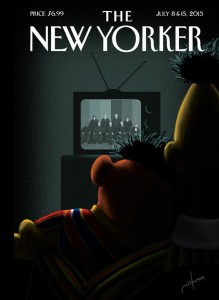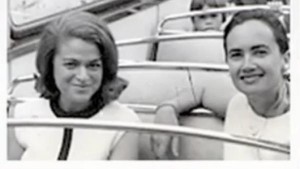 The recent cover the New Yorker Magazine, depicting the Sesame Street muppets Bert and Ernie snuggled together in a darkened room watching the announcement of the overturning of the Defense Of Marriage Act by the US Supreme Court, paving the way for legal gay marriage across the US, was first met with admiration, and then with criticism. Some saw at as a cheap gag, demeaning the importance of a civil rights victory.
The recent cover the New Yorker Magazine, depicting the Sesame Street muppets Bert and Ernie snuggled together in a darkened room watching the announcement of the overturning of the Defense Of Marriage Act by the US Supreme Court, paving the way for legal gay marriage across the US, was first met with admiration, and then with criticism. Some saw at as a cheap gag, demeaning the importance of a civil rights victory.
Bert and Ernie have long been reluctant gay icons. And it is easy to see how one could assume two long term bachelors, living together in New York, one uptight and fastidious, the other an easy going slob, might be considered gay. Hold on, wasn’t that Neil Simon’s The Odd Couple? The debate still continues about that as well.
In 2011 there was an online petition calling for Bert and Ernie to get married on Sesame Street. Spokespersons for Sesame Street’s producers, The Sesame Workshop, replied in no uncertain terms that the two are “best friends. They were created to teach preschoolers that people can be good friends with those who are very different from themselves. Even though they are identified as male characters and possess many human traits and characteristics… they remain puppets, and do not have a sexual orientation.”
Some will argue this statement is undermined by one of the great small screen romances, Miss Piggy and her somewhat reluctant swain, Kermit. While The Muppet Show was a comedic variety extravaganza, rather than a children’s educational show, aimed at both children and an adult audience, it is nevertheless a show with many of the same muppets and puppets. And Miss Piggy’s aggressive blonde bombshell va-va-voom definitely expresses some kind of sexuality.
What that sexuality is exactly, is a difficult question. When a human is sexually attracted to a puppet, it is a form of erotic anthropomorphism, a paraphilia popularly termed puppetophilia or muppetophilia (an actual scientific term has yet to be defined), sub-varieties of agalmatophilia, the sexual attraction to statues or dolls. When it involves a porcine and batrachian attraction, it would be an anthropomorphised-batrachian-puppeto-zoophiliac with asexually displaced non-consummation aggression. Well clearly, because they lack genitalia and the ability to consummate. As you can see, to venture into the taxonomy of muppet-puppet sexuality is to entertain the ridiculous.
To return from the ridiculous to the sublime. Again, Bert and Ernie are life-long friends. They love each other, as friends, despite their differences. Sexuality is irrelevant simply because they don’t have sexuality. They are innocents. With Miss Piggy and Kermit, despite Miss Piggy’s amorous behaviour, sexuality is never, ever implied. These are children’s characters. Their behaviour is innocent, essentially they are still children. As such there is something rather icky about attempting to impose adult behaviours, debates and values on them.
The New Yorker’s cover is inappropriate, the adoption of Bert and Ernie as gay icons is also inappropriate. Perhaps a photo or artwork depicting the wonderful Edith Windsor, who brought the case for marriage equality to the Supreme Court, and her partner of 42 years, Thea Spyer, who sadly passed in 2009, would have been both less cliched and more historically significant.
Young people who are gay need gay role-models on TV. These days there are many. Why be divisive? Why turn it into ‘Us’ and ‘Them’? Young people may just need role models of all sorts of people that are accepting, open, kind to people in all their diversity. Bert and Ernie are there to teach us that people who are very different can still be the closest of friends. Imposing sexuality on them actually detracts from that goal. It also marginalizes gay relationships into well known stereotypes. Bert and Ernie are reluctant gay icons, why impose it upon them?

